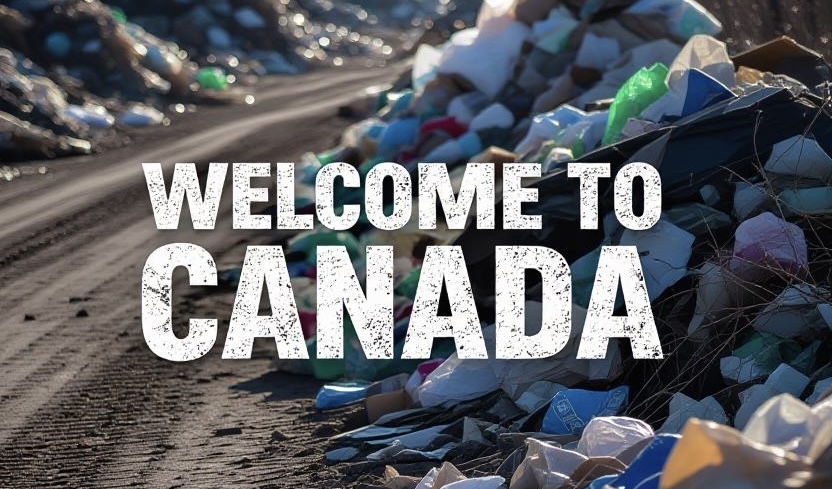Canada’s financial situation looks like a household teetering on the edge of bankruptcy, with federal debt skyrocketing from one trillion dollars in 2015 to over two point one trillion by 2025, a figure that translates to roughly fifty-five thousand dollars per Canadian, piling on pressure as interest costs alone devour fifty billion dollars annually. This debt explosion, driven by relentless deficit spending, saw an extra forty-seven billion dollars added in just the first quarter of 2025, far outpacing earlier projections that promised a more restrained one point eight trillion by 2023. Budgets keep getting tabled after the fact, with spending like the six hundred twenty-three billion dollar borrowing plan for 2025-26 dropped on the public without real-time debate, leaving taxpayers staring at a ballooning tab they had little say in. Meanwhile, the Canadian dollar has tanked twenty percent against the US dollar since 2015, jacking up the cost of everything from groceries, up twenty-five percent, to gas, which has spiked alongside energy prices, crushing families already stretched thin by stagnant wages and a GDP per capita that’s actually shrunk two point five percent below pre-pandemic levels.
Immigration policies seem to be pouring fuel on the fire, with nearly two million newcomers flooding in from 2020 to 2024, mostly from India and Asia, pushing the population from thirty-eight million to over forty-one million and accounting for ninety-eight percent of recent growth. Housing can’t keep up, with only two hundred thousand units built yearly against a need for half a million, sending home prices soaring fifty percent in cities like Toronto and Vancouver while rents climb eleven percent in high-immigrant areas, leaving even newcomers in core housing need at rates fourteen point three percent higher than native-born Canadians. This flood strains healthcare, with wait times stretching to months, and infrastructure, where public transit and roads buckle under the weight. Jobs get hit too, as low-wage roles filled by newcomers depress earnings for young Canadians and established immigrants, with economic output per person lagging as the system groans under the sheer volume of people added without enough planning or resources to support them.
Foreign aid, especially to Ukraine, appears to be a blatant drain, with twenty-two billion dollars committed since 2022, including twelve point four billion in loans, six point five billion in military gear like tanks and drones, and seven hundred million in humanitarian handouts. This works out to about five hundred fifty dollars per Canadian, tacked onto the debt pile while interest costs mount by an estimated two hundred twenty million dollars yearly. Details on where every dollar goes are murky, with Global Affairs Canada releasing broad categories like “budget support” but no line-by-line breakdown, and some reports, like those tied to a two billion dollar loan in 2025, only surface after the money’s already pledged. While Canadians struggle with record food bank usage and a housing crisis, this cash flow to overseas causes, without crystal-clear accounting, feels like a slap in the face, especially when domestic needs like hospitals and schools go begging.
Crime rates are spiking in ways that hit hard at public trust, with the Crime Severity Index up two percent in 2023, violent crime jumping fifty percent since 2015, and gun-related incidents hitting fourteen-year highs. Property crimes like shoplifting surged twenty-eight percent past pre-pandemic levels, and overall crime rates reached five thousand six hundred seventy-two incidents per hundred thousand people by 2024. Court cases show a troubling pattern where newcomers convicted of serious crimes, like a fatal wrong-way crash or sexual offenses, get light sentences—sometimes just months or house arrest—to dodge deportation thresholds, while Canadians face harsher penalties for lesser offenses. Bail reforms in 2023 were supposed to tighten up, but two hundred fifty-six killings in 2022 were linked to released offenders, and thousands of non-citizens with criminal records, including five hundred ninety-nine untracked as of 2025, remain in the country. Protests add to the chaos, with the 2022 Freedom Convoy seeing one hundred ninety-six arrests and heavy police crackdowns, while other demonstrations, like those in October 2024 with foreign flags and chants against Canada, faced delayed responses despite public outcry, feeding a sense that the system bends over backward for outsiders while hammering locals.
Corruption scandals weave a thread of distrust through the government’s actions, starting with the prime minister’s 2016 acceptance of lavish vacations from a donor whose foundation pocketed millions in public funds, a move ruled an ethics violation. The 2019 SNC-Lavalin saga saw allegations of interference to shield a major firm from bribery charges, costing political careers and landing another ethics breach. In 2020, the WE Charity deal handed nearly a billion dollars to an organization tied to the prime minister’s family, with hundreds of thousands in payments to relatives, triggering resignations and probes. The ArriveCan app ballooned to fifty-four million dollars in costs, with audits pointing to cozy insider deals, while the 2024 Green Slush Fund funneled four hundred million dollars to projects linked to political allies, prompting RCMP scrutiny. Foreign interference from China in the 2019 and 2021 elections, confirmed by intelligence reports, went largely unaddressed, with the government downplaying its impact despite targeting Liberal campaigns. These incidents, stacking up over years, paint a picture of leaders who seem more focused on personal networks than public good, with each scandal chipping away at any faith in their stewardship.
National identity takes a hit as symbols and policies shift in ways that feel like a deliberate pivot from tradition, with the 2023 Royal Crown redesign swapping out crosses and fleur-de-lis for generic maple leaves and snowflakes, a move slammed as wiping out heritage for a sanitized, modern look. The passport overhaul that year ditched images of Vimy Ridge and Terry Fox for abstract nature designs, drawing fire for erasing shared history. Multiculturalism policies, ramped up since the 1988 Act, funnel millions into diversity programs while sixty-two percent of recent immigrants hail from Asia, reshaping demographics and fueling debates over whether unity is being sacrificed for fragmented identities. Foreign flags flown at protests, like those in 2024 with anti-Canada slogans, go unpunished despite public outrage, while Canadians waving their own flag during demonstrations face swift crackdowns, creating a stark contrast that stokes resentment. These changes, from anthem tweaks to prioritizing global inclusivity, seem to push a narrative that sidelines the country’s roots for something less defined, leaving many feeling their heritage is being traded away.
Public anger spills out across platforms like X, where thousands of posts rail against the government for piling on debt, with users like @MapleTruth in 2025 calling out two point three trillion dollars in combined federal-provincial debt as a betrayal of future generations. Others slam the twenty-two billion dollars to Ukraine as money laundering or handouts to globalist agendas, pointing to murky reporting and insider ties like those alleged with Brookfield and former officials. Immigration policies draw fire for turning cities into pressure cookers, with @AngryCanuck in 2024 tweeting about rents spiking eleven percent while wages flatline. Crime frustrations boil over, with users citing fifty percent jumps in violence and untracked deportees as proof of a system letting outsiders skate while locals get crushed. Scandals like SNC-Lavalin and WE Charity get dragged up repeatedly, with posts demanding jail time for leaders who seem to skate on ethics breaches. The constant drumbeat of symbol changes, from crowns to passports, gets labeled as an assault on pride, with users asking why foreign flags wave freely while the Maple Leaf feels sidelined. This raw, unfiltered outrage points to a deep sense that the country’s being run into the ground, with every misstep piling onto a growing pile of grievances that feels anything but accidental.
The cumulative weight of these issues, from runaway debt to unchecked immigration, lavish foreign aid, rising crime, serial corruption, and identity shifts, creates a picture where Canada’s leaders seem to be steering toward collapse. The household analogy holds up: no sane family, drowning in seventy thousand dollars of debt on a hundred thousand dollar income, would keep borrowing to hand out cash abroad or ignore their crumbling home. Yet Canada’s government appears to do just that, racking up deficits, letting infrastructure and services strain under population surges, and prioritizing global commitments over local needs, all while scandals expose a pattern of self-interest. The lack of clear, timely budget breakdowns and the soft treatment of certain crimes only deepen the sense that something’s off, with every move seeming to chip away at the country’s stability and spirit, leaving Canadians to wonder why their leaders keep pushing policies that feel so fundamentally out of step with survival.


